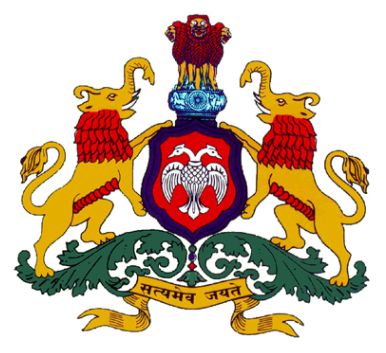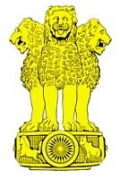Karnataka: Difference between revisions
Knorrepoes (talk | contribs) m (Text replacement - "]] ====Origin/meaning====" to "]] ====Official blazon==== ====Origin/meaning====") |
Knorrepoes (talk | contribs) m (Text replacement - "↵↵Category:Indian States" to " {{in}} {{media}} Category:Indian States") |
||
| (9 intermediate revisions by the same user not shown) | |||
| Line 1: | Line 1: | ||
'''KARNATAKA STATE''' | |||
| | [[File:karnataka.jpg|center|Arms (crest) of {{PAGENAME}}]] | ||
| | |||
{| class="wikitable" | |||
|+Official blazon | |||
|- | |||
|'''English''' | |||
| blazon wanted | |||
|} | |} | ||
===Origin/meaning=== | |||
The arms are based on the arms of the former [[Mysore (State)|Princely State of Mysore]], which forms the main part of the present Karnataka State. The crest has been changed to the Indian National Symbol. | |||
Over centuries the double-headed eagle became incorporated in the Hindu tradition and became popular as <em>‘Gandaberunda’</em>, an avatar of Vishnu. The great dynasties of South India such as the Chalukyas of Vatapi, the Hoysalas of Halebidu in Karnataka, the Kakatiyas of Warangal and Kotas of Guntur in Andhra region, over time adopted <em>Gandaberunda</em> as their chief insignia. The result, this motif can be seen in Chalukyan, Hoysala and Kakatiya temples, across the South. | |||
The Kings of the Vijayanagara empire, who continued this tradition, made the symbol even more popular when they minted the <em>Gandaberunda</em> coins’. The first Vijayanagara ruler to mint these coins was Achyuta Deva Raya the younger brother of the famous Vijayanagara ruler, Krishna Deva Raya, whom he succeeded in 1529. These coins depicted the <em>Gandaberunda</em> holding four elephants in its talons, an act of political symbolism, since the four elephants represented the four Deccani sultanates - Bidar, Bijapur, Ahmadnagar and Golconda, rivals to Vijayanagara. | |||
After the fall of the Vijayanagara empire in the 16th century, <em>Gandaberunda</em> was adopted as the emblem by the Wodeyars of Mysore. And not surprisingly, when the kingdom of Mysore merged with India, the symbol was retained by the enlarged Mysore state which was later renamed Karnataka in 1973. | |||
[[Literature]] : Image from wikipedia; background from https://www.livehistoryindia.com | |||
{{in}} | |||
{{media}} | {{media}} | ||
[[Category:Indian States]] | [[Category:Indian States]] | ||
[[Category:India]] | [[Category:India]] | ||
Latest revision as of 07:30, 29 July 2024
KARNATAKA STATE
| English | blazon wanted |
Origin/meaning
The arms are based on the arms of the former Princely State of Mysore, which forms the main part of the present Karnataka State. The crest has been changed to the Indian National Symbol.
Over centuries the double-headed eagle became incorporated in the Hindu tradition and became popular as ‘Gandaberunda’, an avatar of Vishnu. The great dynasties of South India such as the Chalukyas of Vatapi, the Hoysalas of Halebidu in Karnataka, the Kakatiyas of Warangal and Kotas of Guntur in Andhra region, over time adopted Gandaberunda as their chief insignia. The result, this motif can be seen in Chalukyan, Hoysala and Kakatiya temples, across the South.
The Kings of the Vijayanagara empire, who continued this tradition, made the symbol even more popular when they minted the Gandaberunda coins’. The first Vijayanagara ruler to mint these coins was Achyuta Deva Raya the younger brother of the famous Vijayanagara ruler, Krishna Deva Raya, whom he succeeded in 1529. These coins depicted the Gandaberunda holding four elephants in its talons, an act of political symbolism, since the four elephants represented the four Deccani sultanates - Bidar, Bijapur, Ahmadnagar and Golconda, rivals to Vijayanagara.
After the fall of the Vijayanagara empire in the 16th century, Gandaberunda was adopted as the emblem by the Wodeyars of Mysore. And not surprisingly, when the kingdom of Mysore merged with India, the symbol was retained by the enlarged Mysore state which was later renamed Karnataka in 1973.
Literature : Image from wikipedia; background from https://www.livehistoryindia.com
India heraldry portal
This page is part of the India heraldry portal |
Heraldry of the World |
|
Civic heraldry:
|
Other heraldry:
|
Contact and Support
Partners:
Your logo here ?
Contact us
© since 1995, Heraldry of the World, Ralf Hartemink
Index of the site


